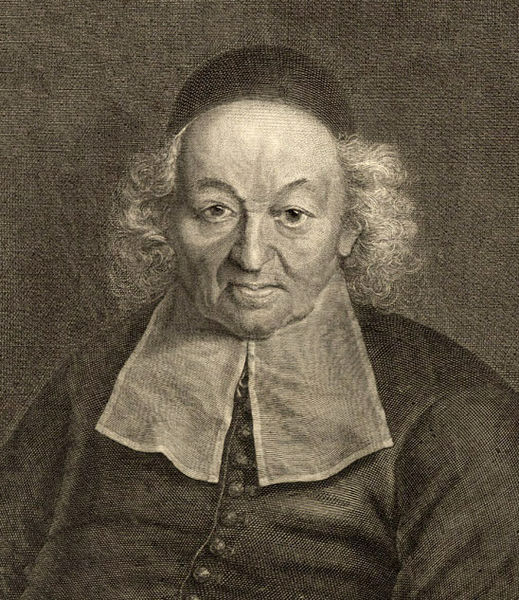.
Ismaël Bullialdus
Ismaël Bullialdus (September 28, 1605 – November 25, 1694) was a French astronomer.
Bullialdus was born Ismaël Boulliau in Loudun, Vienne, France, the first surviving son to Calvinists Susanna Motet and Ismaël Boulliau, a notary by profession and amateur astronomer. At age twenty-one he converted to Catholicism, and by twenty-six was ordained as a priest. In 1632 he moved to Paris, where he worked as a librarian for the Bibliothèque du Roi with brothers Pierre and Jacques Dupuy, traveling widely within Italy, Holland, and Germany to purchase books. In 1657 he became secretary to the French ambassador to Holland, then once again a librarian, and in 1666 moved to the Collège de Laon. During the final five years of his life, he returned to the priesthood at the Abbey St Victor in Paris, where he died.
Bullialdus was a friend of Pierre Gassendi, Christiaan Huygens, Marin Mersenne, and Blaise Pascal, and an active supporter of Galileo Galilei and Nicolaus Copernicus. It is for his astronomical and mathematical works that he is best known. Chief among them is his Astronomia philolaica, (published 1645). In this work he strongly supported Kepler's hypothesis that the planets travel in elliptical orbits around the Sun, but argued against the physical theory the latter had proposed to explain them.[1] In particular, he objected to Kepler's proposal that the strength of the force exerted on the planets by the Sun decreases in inverse proportion to their distance from it. He argued that if such a force existed it would instead have to follow an inverse-square law:[2]

Ismaël Bullialdus
As for the power by which the Sun seizes or holds the planets, and which, being corporeal, functions in the manner of hands, it is emitted in straight lines throughout the whole extent of the world, and like the species of the Sun, it turns with the body of the Sun; now, seeing that it is corporeal, it becomes weaker and attenuated at a greater distance or interval, and the ratio of its decrease in strength is the same as in the case of light, namely, the duplicate proportion, but inversely, of the distances that is, 1/d².[3]
However, Bullialdus did not believe that any such force did in fact exist.[2] After writing the above-quoted passage, he then went on to write:
... I say that the Sun is moved by its own form around its axis, by which form it was ignited and made light, indeed I say that no kind of motion presses upon the remaining planets ... indeed [I say] that the individual planets are driven round by individual forms with which they were provided ...[3]
In his Principia Mathematica of 1687, Isaac Newton acknowledged that Bullialdus's determination of the sizes of the planets' orbits ranked with Kepler's as the most accurate then available.[4]
Bullialdus was one of the earliest members of the Royal Society, London, having been elected on April 4, 1667, seven years after its founding. The Moon's Bullialdus crater is named in his honor.
Principal works
De natura lucis (1638)
Philolaus (1639)
Expositio rerum mathematicarum ad legendum Platonem utilium, translation of Theon of Smyrna (1644)
Astronomia philolaica (1645)
De lineis spiralibus (1657)
Opus novum ad arithmeticam infinitorum (1682)
Ad astronomos monita duo (1667)
See Also
List of Roman Catholic scientist-clerics
Notes
^ Linton (2004, p.224)
^ a b Linton (2004, p.225), O'Connor and Robertson (2006). An on-line electronic copy of the latter reference is available.
^ a b O'Connor and Robertson (2006)
^ Newton (c.1846, Phenomenon IV, Book III, p.388): "And as to the measures of the periodic times, all astronomers are agreed about them. But for the dimensions of the orbits, Kepler and Bullialdus, above all others, have determined them from observations with the greatest accuracy; and the mean distances corresponding to the periodic times differ but insensibly from those they have assigned, and for the most part fall in between them; as may be seen in the following table."
References
Linton, Christopher M. (2004). From Eudoxus to Einstein—A History of Mathematical Astronomy. Cambridge: Cambridge University Press. ISBN 978-0-521-82750-8.
Newton, Isaac (c.1846) [First published, 1687, in Latin]. Newton's Principia: The mathematical principles of natural philosophy. translated by Andrew Motte (First American ed.). New York: Daniel Adee. Retrieved 06-04-2009.
O'Connor, John J. and Roberson, Edmund F. (August 2006). "Ismael Boulliau". The MacTutor History of Mathematics Archive. St Andrews: School of Mathematics and Statistics, University of St Andrews. Retrieved 07-04-2009.
Further reading
Nellen, H. J. M., Ismaël Boulliau (1605-1694), astronome, épistolier, nouvelliste et intermédiaire scientifique, Studies of the Pierre Bayle Institute Nijmegen (SIB), 24, APA-Holland University Press, 1994. ISBN 90-302-1034-6.
External links
Short biography
Retrieved from "http://en.wikipedia.org/"
All text is available under the terms of the GNU Free Documentation License

